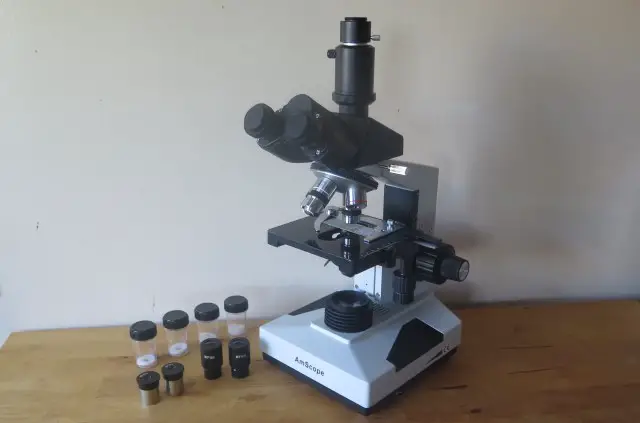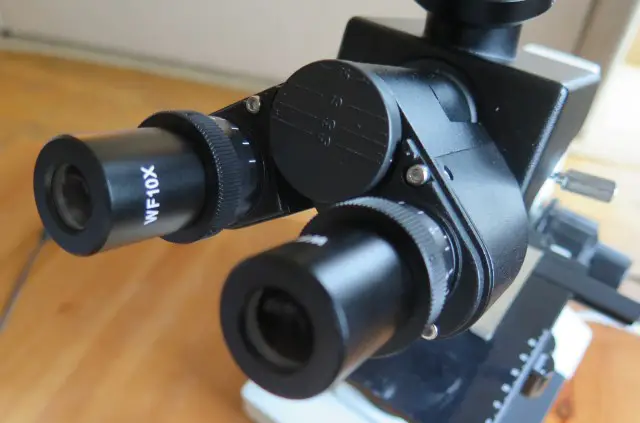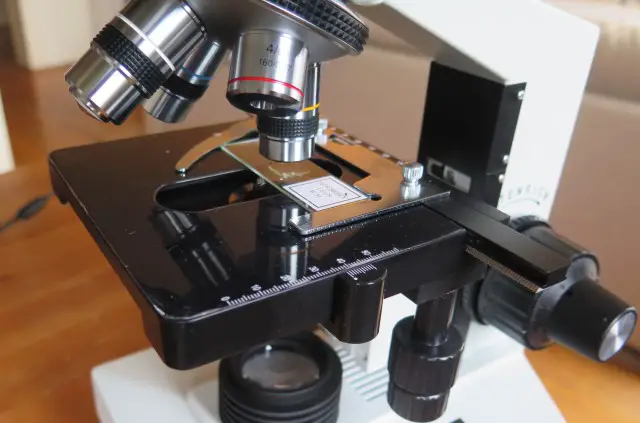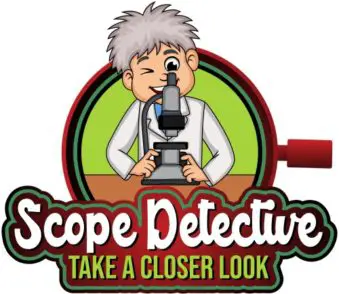 About this Article: I researched 9 microscopes before buying this one. This information was for my personal circumstances only and is not professional advice to you. Read more on the website’s disclaimer page. All images on this page are my own. As an Amazon associate I earn from qualifying purchases.
About this Article: I researched 9 microscopes before buying this one. This information was for my personal circumstances only and is not professional advice to you. Read more on the website’s disclaimer page. All images on this page are my own. As an Amazon associate I earn from qualifying purchases.The Amscope T490B is my own microscope! It’s the one I bought after completing my reviews of 9 of the best compound microscopes on the market. Here’s a picture of it straight after I got it out of the box:

So far, I’m really happy with it.
It is a high-end compound trinocular microscope that’s ideal for people recording their observations. The turret at the top allows you to record to camera. Personally, I got a DSLR to microscope adaptor to round out the kid.
This is a step up from a binocular model where you would usually have to record the specimen through the angled eyepiece, which is awkward.
Beyond this one big benefit, there’s a lot to like about the Amscope T490B. It’s got advanced features like:
- Siedentopf head
- Abbe condenser with Iris diaphragm
- Oil immersion lens
- Mechanical stage
- Vertical focus lock
- Stage tension wheel and
- A both-side diopter
These are higher-end features that provide improved user experience compared to entry-level models like the Amscope M150C-MS.
The magnification range for this microscope is 40X-2000X, with the higher-end magnification best done through oil immersion methods to get clear results.
The main downside of this microscope is that the camera needs to be bought separately. While this does give you flexibility to buy whichever camera you like, there’s no ‘package deal’ to save you money.
My Verdict: This is a high quality trinocular microscope with an excellent range of features. The big question is whether you want to get this and buy a camera separately, or go for a trinocular microscope with a camera already included.
Amscope T490B Review
Below, I’ll review all the features from top to bottom.
1. Trinocular Head
The Amscope T490B has a simul-focal trinocular head. Simul-focal means that you’d be able to see through all optical lenses at once. This is important to allow you to record from the top scope while also looking through the regular binocular lenses. Here’s the microscope set up with my camera on top:

The photo port is 23.3mm in diameter – remember this when you get a camera. Most camera to microscope adaptors are designed to fit 23.3mm tubes, but it’s worth checking first.
The binocular section of the head uses compensation-free Siedentopf technology. A Siedentopf head is used in most higher-end binocular microscopes these days because it allows you to change the ‘interpupillary distance’ without losing focus. In layman’s terms: you can adjust the binoculars so they’re comfortable without losing focus. Here’s a photo of the Siedentopf head on this microscope:

The binocular section is at a 30° incline and 360° rotatable. This is pretty standard for a microscope of this size.
I found it interesting that they have diopeters on both ocular lenses. Diopeters are useful for people who have different vision between both eyes. I don’t use diopeters because I don’t have this problem. But it was interesting to see a diopeter on both sides, because theoretically you only need one.
2. Ocular and Objective Lenses
Magnification is achieved through 2 ocular lens options and 4 objective lenses. The interchangeable ocular lenses are 10X and 20X which is really quite standard in microscopes of all varieties.
Most microscopes of this quality have four objective lenses. Lower-end ones will have three, where the 100X lens will be missing. The four objective lenses in this microscope are 4X, 10X, 40X, and 100X.
As would be expected, the 40X and 100X objectives are spring loaded to prevent breaking the lenses in case they bump up against the stage. Remember to only use the fine focus adjustment knob at higher magnification to minimize chances of causing damage further.
The 100X lens is also designed for oil immersion at 2000X which, again, one would expect.
The overall possible magnifications are: 40x, 80x, 100x, 200x, 400x, 800x, 1000x, and 2000x.
3. Stage
The microscope’s stage has some features that I am impressed by, too. Again, they’ve gone out of their way to provide features that most lower-end microscopes rarely provide.
But first – the basics: yes, it’s a mechanical stage (very important to me). The user experience of a mechanical stage over a vertical-only stage is massive in my opinion. The stage has an X-Y translation range of 75mm x 45mm which is more than enough.
Here’s a picture of the mechanical stage:

But I also like that they’ve included a vertical focus lock (also known as a ‘stop limit knob’). These allow you to find a perfect focus point, save that exact point, then lower the stage to change out slides. You can then return the stage to the exact same setting with perfect focus.
There’s also a tension wheel included in behind the coarse focus knob, which I’ve never really understood. I just keep it nice and tight to prevent the stage from drifting out of focus.
4. Lighting
One thing I’m not a big fan of is the fact this microscope uses a 20W Halogen Light. I know there’s some debate between Halogen vs LED, but I sit on the side of LED in that debate.
Of course, many people may prefer halogen lighting so this is a personal preference thing. And really, it doesn’t affect my user experience all that much (or at all really).
Besides that, there’s an industry standard achromatic Abbe condenser with NA1.25 for adjusting the lighting aperture. Inside this condenser is an iris diaphragm – again, no less than I’d expect.
There’s also a very easily accessible color filter holder that flicks out below the condenser. They have included blue, green and yellow condensers in the package to help get the lighting as natural as possible.
Overall, the lighting setup is as expected at meets my standards.
The lighting is only operated by power plug, not batteries. This is normal for microscopes in this category.
5. Add-Ons
There are not a huge range of add-ons for this microscope, but there are some nice things included still. One thing I appreciate is that they include a spare halogen bulb and spare fuse for when they inevitably break. Make sure you dim the lighting before turning off the microscope to increase the lifespan of that first bulb.
There’s also an included dust cover and sample immersion oil as expected.
Downsides
Despite the overall quality of this microscope, there are a few small downsides:
- No Camera: Despite the fact trinocular microscopes are designed for photomicrography, there isn’t a camera included in this kit. You’ll need to buy one separately – remember to get a 23mm camera. I prefer at least 2MP for high resolution images.
- Not Designed for Darkfield Microscopy: AmScope provides a version of this microscope with a darkfield condenser included. Personally, I’d get an aftermarket darkfield stop that I could retrofit into the condenser (or just use the old dime on the condenser trick), which would give the microscope the ability to do both darkfield and brightfield microscopy.
My Verdict
Overall, I think this is a really nice high-end trinocular microscope. It’s got some great user-friendly features like that stage stop for saving your perfect focus position.
The main question that needs to be asked is whether you want to get this one and buy a camera adapter separately for your DSLR, or get a package which includes both a trinocular microscope and a camera together. If so, don’t forget that you’ll only get half decent images from a 5MP camera or higher, remembering that if you want photos the quality of a normal iPhone camera, you’d want about 12MP.
For me, it was the perfect microscope, and I’m really happy with my purchase.
Hi, I’m Chris and I run things around here! I share all my microscopy experiments, microscope information and tricks, how to guides, and microscope reviews in the articles on this site. Browse around to see what you like (I recommend the experiment ideas section) or connect with me on any of the social platforms listed below.

